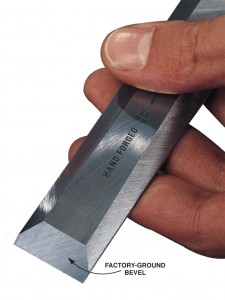We may receive a commission when you use our affiliate links. However, this does not impact our recommendations.
Whenever I buy a blade, like a tablesaw blade or a router bit, it’s always sharp. How come when I buy chisels they’re duller than a math lecture on the last day of school?
A:
Although it seems reasonable to expect new chisels to come sharp, there are three good reasons why they don’t.
First, sharpening is expensive. Some chisels do come presharpened, but they cost about $5 more per chisel. Would you be willing to pay for the first sharp edge when you’ll resharpen your chisel dozens of times?
Second, the roughly ground edge on a new chisel is actually a useful secondary bevel. At 25 degrees, it’s a lower angle than the chisel is meant to cut at. Your job is to hone the chisel to the primary angle: 30 degrees. The manufacturer has saved you some time by giving you a lower angle so now you have only to hone the tip of the chisel.
Third, a sharp edge is fragile. Chances are it wouldn’t survive shipping and handling. With a dull edge, you know what you’ve got.
Here are some supplies and tools we find essential in our everyday work around the shop. We may receive a commission from sales referred by our links; however, we have carefully selected these products for their usefulness and quality.










It’s not really that expensive if done using volume production methods. Razor blades are sharp and cheap. That is because of the automated process used in their manufacture to get them sharp. It is only the low production (i.e., labor intensive) sharpening process that is expensive.
RE: flattening the back
Most plane irons and chisels that I’ve had to sharpen come with a fairly flat back. There may be grinding marks that need to be removed, but that really doesn’t take long. Start with a coarse stone and only flatten 1/4 to 1/2 inch of the back. The more area you choose to flatten, the longer it will take. When I first started sharpening chisels, it was a real chore because I was starting with too fine of a stone and trying to flatten too much surface area.
My frustration with new chisels and plane irons is the lack of flatness of the backs, no matter the brand of tool, or whether I use sandpaper and granite or use diamond plates. Any thoughts? This is such a time-consuming part of sharpening a new tool.